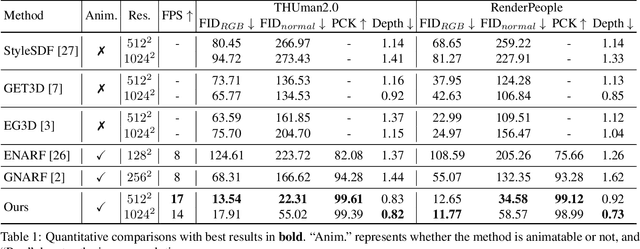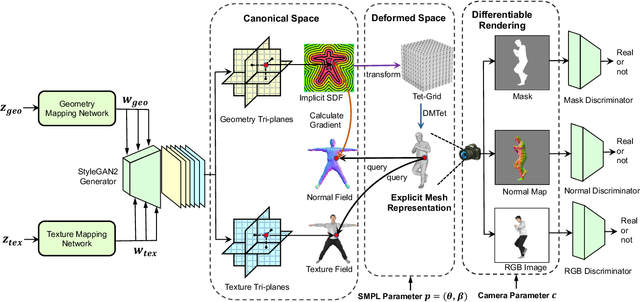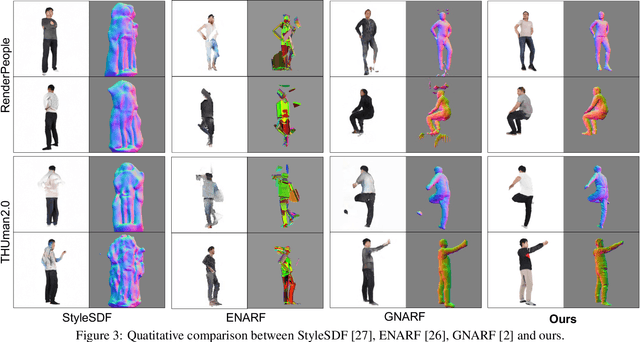Guoxian Song
$A^2R^2$: Advancing Img2LaTeX Conversion via Visual Reasoning with Attention-Guided Refinement
Jul 28, 2025Abstract:Img2LaTeX is a practically significant task that involves converting mathematical expressions or tabular data from images into LaTeX code. In recent years, vision-language models (VLMs) have demonstrated strong performance across a variety of visual understanding tasks, owing to their generalization capabilities. While some studies have explored the use of VLMs for the Img2LaTeX task, their performance often falls short of expectations. Empirically, VLMs sometimes struggle with fine-grained visual elements, leading to inaccurate LaTeX predictions. To address this challenge, we propose $A^2R^2$: Advancing Img2LaTeX Conversion via Visual Reasoning with Attention-Guided Refinement, a framework that effectively integrates attention localization and iterative refinement within a visual reasoning framework, enabling VLMs to perform self-correction and progressively improve prediction quality. For effective evaluation, we introduce a new dataset, Img2LaTex-Hard-1K, consisting of 1,100 carefully curated and challenging examples designed to rigorously evaluate the capabilities of VLMs within this task domain. Extensive experimental results demonstrate that: (1) $A^2R^2$ significantly improves model performance across six evaluation metrics spanning both textual and visual levels, consistently outperforming other baseline methods; (2) Increasing the number of inference rounds yields notable performance gains, underscoring the potential of $A^2R^2$ in test-time scaling scenarios; (3) Ablation studies and human evaluations validate the practical effectiveness of our approach, as well as the strong synergy among its core components during inference.
Texture or Semantics? Vision-Language Models Get Lost in Font Recognition
Mar 31, 2025Abstract:Modern Vision-Language Models (VLMs) exhibit remarkable visual and linguistic capabilities, achieving impressive performance in various tasks such as image recognition and object localization. However, their effectiveness in fine-grained tasks remains an open question. In everyday scenarios, individuals encountering design materials, such as magazines, typography tutorials, research papers, or branding content, may wish to identify aesthetically pleasing fonts used in the text. Given their multimodal capabilities and free accessibility, many VLMs are often considered potential tools for font recognition. This raises a fundamental question: Do VLMs truly possess the capability to recognize fonts? To investigate this, we introduce the Font Recognition Benchmark (FRB), a compact and well-structured dataset comprising 15 commonly used fonts. FRB includes two versions: (i) an easy version, where 10 sentences are rendered in different fonts, and (ii) a hard version, where each text sample consists of the names of the 15 fonts themselves, introducing a stroop effect that challenges model perception. Through extensive evaluation of various VLMs on font recognition tasks, we arrive at the following key findings: (i) Current VLMs exhibit limited font recognition capabilities, with many state-of-the-art models failing to achieve satisfactory performance. (ii) Few-shot learning and Chain-of-Thought (CoT) prompting provide minimal benefits in improving font recognition accuracy across different VLMs. (iii) Attention analysis sheds light on the inherent limitations of VLMs in capturing semantic features.
X-Dancer: Expressive Music to Human Dance Video Generation
Feb 24, 2025Abstract:We present X-Dancer, a novel zero-shot music-driven image animation pipeline that creates diverse and long-range lifelike human dance videos from a single static image. As its core, we introduce a unified transformer-diffusion framework, featuring an autoregressive transformer model that synthesize extended and music-synchronized token sequences for 2D body, head and hands poses, which then guide a diffusion model to produce coherent and realistic dance video frames. Unlike traditional methods that primarily generate human motion in 3D, X-Dancer addresses data limitations and enhances scalability by modeling a wide spectrum of 2D dance motions, capturing their nuanced alignment with musical beats through readily available monocular videos. To achieve this, we first build a spatially compositional token representation from 2D human pose labels associated with keypoint confidences, encoding both large articulated body movements (e.g., upper and lower body) and fine-grained motions (e.g., head and hands). We then design a music-to-motion transformer model that autoregressively generates music-aligned dance pose token sequences, incorporating global attention to both musical style and prior motion context. Finally we leverage a diffusion backbone to animate the reference image with these synthesized pose tokens through AdaIN, forming a fully differentiable end-to-end framework. Experimental results demonstrate that X-Dancer is able to produce both diverse and characterized dance videos, substantially outperforming state-of-the-art methods in term of diversity, expressiveness and realism. Code and model will be available for research purposes.
X-Dyna: Expressive Dynamic Human Image Animation
Jan 20, 2025Abstract:We introduce X-Dyna, a novel zero-shot, diffusion-based pipeline for animating a single human image using facial expressions and body movements derived from a driving video, that generates realistic, context-aware dynamics for both the subject and the surrounding environment. Building on prior approaches centered on human pose control, X-Dyna addresses key shortcomings causing the loss of dynamic details, enhancing the lifelike qualities of human video animations. At the core of our approach is the Dynamics-Adapter, a lightweight module that effectively integrates reference appearance context into the spatial attentions of the diffusion backbone while preserving the capacity of motion modules in synthesizing fluid and intricate dynamic details. Beyond body pose control, we connect a local control module with our model to capture identity-disentangled facial expressions, facilitating accurate expression transfer for enhanced realism in animated scenes. Together, these components form a unified framework capable of learning physical human motion and natural scene dynamics from a diverse blend of human and scene videos. Comprehensive qualitative and quantitative evaluations demonstrate that X-Dyna outperforms state-of-the-art methods, creating highly lifelike and expressive animations. The code is available at https://github.com/bytedance/X-Dyna.
High Quality Human Image Animation using Regional Supervision and Motion Blur Condition
Sep 29, 2024



Abstract:Recent advances in video diffusion models have enabled realistic and controllable human image animation with temporal coherence. Although generating reasonable results, existing methods often overlook the need for regional supervision in crucial areas such as the face and hands, and neglect the explicit modeling for motion blur, leading to unrealistic low-quality synthesis. To address these limitations, we first leverage regional supervision for detailed regions to enhance face and hand faithfulness. Second, we model the motion blur explicitly to further improve the appearance quality. Third, we explore novel training strategies for high-resolution human animation to improve the overall fidelity. Experimental results demonstrate that our proposed method outperforms state-of-the-art approaches, achieving significant improvements upon the strongest baseline by more than 21.0% and 57.4% in terms of reconstruction precision (L1) and perceptual quality (FVD) on HumanDance dataset. Code and model will be made available.
X-Portrait: Expressive Portrait Animation with Hierarchical Motion Attention
Mar 27, 2024Abstract:We propose X-Portrait, an innovative conditional diffusion model tailored for generating expressive and temporally coherent portrait animation. Specifically, given a single portrait as appearance reference, we aim to animate it with motion derived from a driving video, capturing both highly dynamic and subtle facial expressions along with wide-range head movements. As its core, we leverage the generative prior of a pre-trained diffusion model as the rendering backbone, while achieve fine-grained head pose and expression control with novel controlling signals within the framework of ControlNet. In contrast to conventional coarse explicit controls such as facial landmarks, our motion control module is learned to interpret the dynamics directly from the original driving RGB inputs. The motion accuracy is further enhanced with a patch-based local control module that effectively enhance the motion attention to small-scale nuances like eyeball positions. Notably, to mitigate the identity leakage from the driving signals, we train our motion control modules with scaling-augmented cross-identity images, ensuring maximized disentanglement from the appearance reference modules. Experimental results demonstrate the universal effectiveness of X-Portrait across a diverse range of facial portraits and expressive driving sequences, and showcase its proficiency in generating captivating portrait animations with consistently maintained identity characteristics.
DiffPortrait3D: Controllable Diffusion for Zero-Shot Portrait View Synthesis
Dec 22, 2023



Abstract:We present DiffPortrait3D, a conditional diffusion model that is capable of synthesizing 3D-consistent photo-realistic novel views from as few as a single in-the-wild portrait. Specifically, given a single RGB input, we aim to synthesize plausible but consistent facial details rendered from novel camera views with retained both identity and facial expression. In lieu of time-consuming optimization and fine-tuning, our zero-shot method generalizes well to arbitrary face portraits with unposed camera views, extreme facial expressions, and diverse artistic depictions. At its core, we leverage the generative prior of 2D diffusion models pre-trained on large-scale image datasets as our rendering backbone, while the denoising is guided with disentangled attentive control of appearance and camera pose. To achieve this, we first inject the appearance context from the reference image into the self-attention layers of the frozen UNets. The rendering view is then manipulated with a novel conditional control module that interprets the camera pose by watching a condition image of a crossed subject from the same view. Furthermore, we insert a trainable cross-view attention module to enhance view consistency, which is further strengthened with a novel 3D-aware noise generation process during inference. We demonstrate state-of-the-art results both qualitatively and quantitatively on our challenging in-the-wild and multi-view benchmarks.
DREAM-Talk: Diffusion-based Realistic Emotional Audio-driven Method for Single Image Talking Face Generation
Dec 21, 2023



Abstract:The generation of emotional talking faces from a single portrait image remains a significant challenge. The simultaneous achievement of expressive emotional talking and accurate lip-sync is particularly difficult, as expressiveness is often compromised for the accuracy of lip-sync. As widely adopted by many prior works, the LSTM network often fails to capture the subtleties and variations of emotional expressions. To address these challenges, we introduce DREAM-Talk, a two-stage diffusion-based audio-driven framework, tailored for generating diverse expressions and accurate lip-sync concurrently. In the first stage, we propose EmoDiff, a novel diffusion module that generates diverse highly dynamic emotional expressions and head poses in accordance with the audio and the referenced emotion style. Given the strong correlation between lip motion and audio, we then refine the dynamics with enhanced lip-sync accuracy using audio features and emotion style. To this end, we deploy a video-to-video rendering module to transfer the expressions and lip motions from our proxy 3D avatar to an arbitrary portrait. Both quantitatively and qualitatively, DREAM-Talk outperforms state-of-the-art methods in terms of expressiveness, lip-sync accuracy and perceptual quality.
MagicDance: Realistic Human Dance Video Generation with Motions & Facial Expressions Transfer
Nov 18, 2023Abstract:In this work, we propose MagicDance, a diffusion-based model for 2D human motion and facial expression transfer on challenging human dance videos. Specifically, we aim to generate human dance videos of any target identity driven by novel pose sequences while keeping the identity unchanged. To this end, we propose a two-stage training strategy to disentangle human motions and appearance (e.g., facial expressions, skin tone and dressing), consisting of the pretraining of an appearance-control block and fine-tuning of an appearance-pose-joint-control block over human dance poses of the same dataset. Our novel design enables robust appearance control with temporally consistent upper body, facial attributes, and even background. The model also generalizes well on unseen human identities and complex motion sequences without the need for any fine-tuning with additional data with diverse human attributes by leveraging the prior knowledge of image diffusion models. Moreover, the proposed model is easy to use and can be considered as a plug-in module/extension to Stable Diffusion. We also demonstrate the model's ability for zero-shot 2D animation generation, enabling not only the appearance transfer from one identity to another but also allowing for cartoon-like stylization given only pose inputs. Extensive experiments demonstrate our superior performance on the TikTok dataset.
GETAvatar: Generative Textured Meshes for Animatable Human Avatars
Oct 04, 2023



Abstract:We study the problem of 3D-aware full-body human generation, aiming at creating animatable human avatars with high-quality textures and geometries. Generally, two challenges remain in this field: i) existing methods struggle to generate geometries with rich realistic details such as the wrinkles of garments; ii) they typically utilize volumetric radiance fields and neural renderers in the synthesis process, making high-resolution rendering non-trivial. To overcome these problems, we propose GETAvatar, a Generative model that directly generates Explicit Textured 3D meshes for animatable human Avatar, with photo-realistic appearance and fine geometric details. Specifically, we first design an articulated 3D human representation with explicit surface modeling, and enrich the generated humans with realistic surface details by learning from the 2D normal maps of 3D scan data. Second, with the explicit mesh representation, we can use a rasterization-based renderer to perform surface rendering, allowing us to achieve high-resolution image generation efficiently. Extensive experiments demonstrate that GETAvatar achieves state-of-the-art performance on 3D-aware human generation both in appearance and geometry quality. Notably, GETAvatar can generate images at 512x512 resolution with 17FPS and 1024x1024 resolution with 14FPS, improving upon previous methods by 2x. Our code and models will be available.
 Add to Chrome
Add to Chrome Add to Firefox
Add to Firefox Add to Edge
Add to Edge